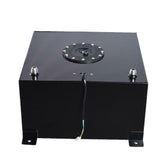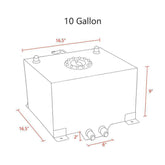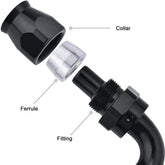Introduced in 1951, power steering was designed to help drivers steer vehicles with ease. In an age when cars are getting bigger and heavier, it's a welcome technological advancement. It takes more energy to move objects with greater mass, especially at low speeds.
Classic power steering systems use a power steering pump to move pressurized hydraulic oil to assist, while some modern designs use electric motors.
It's often said that hydraulic power steering provides better steering feel, but with recent developments in electric power steering, that's not always the case. Electric power steering systems are generally maintenance-free and slightly better fuel economy because they have no power steering pump and are not driven by the accessory belt.
Read on to learn how a hydraulic power steering pump works, what are the symptoms of a power steering pump failure, and how much it will cost to replace it if it fails.
How Power Steering Pumps Work
Power steering fluid is pressurized by the power steering pump and delivered from the tank to the steering gear through the pump output. While the vehicle is in motion, the pump is powered by a pulley that is connected to the vehicle's accessory belt.
The fluid applies pressure to the steering gear, turning the wheels. The pressure increases with increasing engine speed. Since there must be enough pressure at idle to turn the wheels, the pressure at high engine rpm is usually unnecessary. This excess pressure is dissipated via a pressure reducing valve.
The car shouldn't apply steering assistance to the wheels when the steering wheel isn't turning, so a sensor called a rotary valve uses a torsion bar to determine when the wheels are turning. The torsion bar will twist when torque is applied.
One end of the torsion bar is attached to the steering wheel and the other end is attached to the steering gear. This ensures that the amount of torque applied to the steering wheel is equal to that applied to the wheels. This is how the driver controls the degree to which the front wheels are turned.
It's not safe to drive without a functioning power steering pump, as it affects how the driver's input moves the car.
Vehicles with a damaged power steering pump have noticeably higher steering forces, to the point that some occupants may not even be able to turn the steering wheel at all! In general, the heavier the vehicle, the more difficult it will be to turn the wheels without assistance.
NOTE: Driving a vehicle with a power steering malfunction can be more difficult than driving the same vehicle without power steering. This is caused by drag from the power steering components, which creates a drag on the system that the driver must overcome. Also, the manual (non-power) steering is slower than usual, which means the driver has more leverage to the front wheels.
Power Steering Pump Symptoms
All parts of a car have a finite life, and the power steering pump is no exception. Watch out for (and listen to) these unusual behaviors. These abnormal behaviors could indicate a problem with the steering pump. If you find any of these, have a mechanic check them out to prevent irreversible damage to your pump.
1. Low and/or leaking power steering fluid
Power steering fluid is an important part of the pump, so running the pump with insufficient power steering fluid can cause problems. Pumps can also suffer physical damage from wear or age.
The reservoir for power steering fluid is located under the hood, usually on the passenger side of the vehicle, but this depends on how the engine is mounted. Check fluid level to make sure it is within proper range. There should be a low mark on the reservoir and a full mark on it.
If a leak is found between the pump and the reservoir, the affected component should be repaired before driving the vehicle to reduce damage. Power steering fluid is usually red or reddish-brown, so seeing puddles of this color under the vehicle is a great clue that something may be wrong with the power steering pump.
2. Gray Power Steering Fluid and/or Visible Flakes
When checking the fuel tank level, note the color of the power steering fluid. If it is gray, it has oxidized and is not working properly. Oxidation occurs when excess air enters the system as it may pass through a malfunctioning power steering pump.
A bad pump can sometimes cause flakes (gray or chrome) to appear in the power steering fluid. Metal-to-metal friction and material wear due to degradation may be the culprits.
3. Squealing sound on startup
This is a common symptom when an accessory belt is loose, but it can also indicate a damaged power steering pump. Before replacing the pump, first check to make sure the tension is set correctly on the accessory belt.









